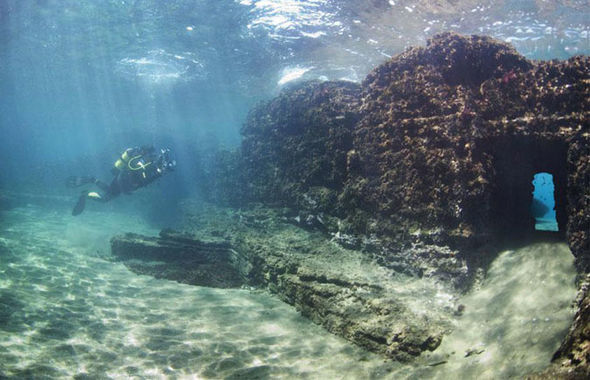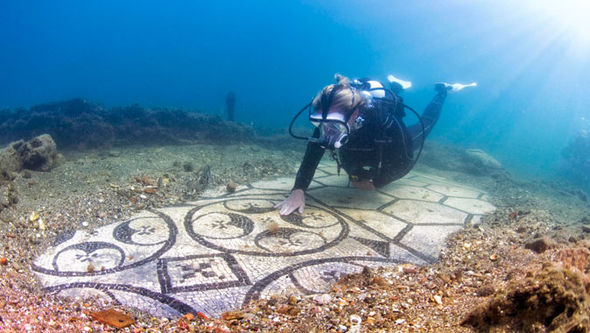Beneath the waves lies history: An immense Roman city has been discovered under the sea, unveiling secrets of an ancient civilization

: Divers discovered figures dating back nearly 2,000 years that reflect Baiae’s glory
In the Bay of Naples lies a lost wonder of the ancient world where mosaic floors shimmer beneath the warm turquoise waters of the Mediterranean Sea.
Today, the barnacle-encrusted statuary of Baiae – 150 miles south of Rome – is home to shoals of fi sh but in the 1st Century AD this fashionable seaside resort was the playground of the Roman elite and a celebrated retreat from the pressures of city life.
A favourite of emperors and Rome’s super-rich including Julius Caesar, Nero and Hadrian, it was the setting for parties, love affairs and plots against political rivals.
Said to have been named after Baius – the helmsman of Odysseus’s ship in Homer’s Odyssey – Baiae sank beneath the waves 1,700 years ago.
Now its grandeur has been revealed again in a stunning series of underwater photographs that reveal luxury villas and wide cobbled pavements, down which Roman nobility would have paraded, as well as the priceless statues and mosaic floors which made this town in the shadow of Mount Vesuvius a jewel of the Mediterranean coastline.

“Diving here is a dive into history,” says Italian photographer Antonio Busiello who took new pictures of this Las Vegas of the Roman Empire.
“Looking at ancient ruins underwater is a beautiful experience indeed.”
For centuries the resort was at the heart of Roman culture. It had spa baths as well as ingeniously engineered fresh-water pools which supplied its visitors with oysters.

Archaeologists dive down to explore Baiae’s mosaics and avenues
Divers explore Hinatuan Enchanted River’s underwater cave
Become an Express Premium member
- Support fearless journalism
- Read The Daily Express online, advert free
- Get super-fast page loading
Diving here is a dive into history
Antonio Busiello, photographer
“It was one of the most important Roman cities,” says Busiello.
“The beautiful mosaics and the villas and temples that are still underwater show the opulence and wealth of this area.”
It was also extremely decadent. Statesman and philosopher Seneca warned that visitors will see “persons wandering drunk along the beach, the riotous revelling of sailing parties, the lakes a-din with choral song and all the other ways in which luxury blazons its sins”.
None of this was enough to deter Pliny the Younger who was in Baiae when he witnessed the 79 AD eruption of Mount Vesuvius that destroyed Pompeii and Herculaneum.
And just over 200 years after that event Baiae fell victim to another natural catastrophe which led to it being submerged beneath the waves off Italy’s west coast.
In the early 4th century the chambers of molten volcanic rock that lay beneath the town – and which had provided a source of natural heat for its famous spa baths – emptied as the lava found a way to escape, causing the resort to be inundated by the sea.
Despite this some parts of the city remain perfectly preserved 17 centuries later.

Underwater photographs reveal the scale and beauty of Baiae resort near Naples
They include an opulent villa owned by the famed Piso family, which had its own jetty and two huge bath complexes.
It was here that the owner, Gaius Calpurnius Piso, had planned to assassinate his friend the Emperor Nero so that he could become emperor in his place.
When the plot was uncovered Nero ordered Piso to commit suicide.
The location of the villa at the heart of one of the greatest scandals in Roman history was revealed by a section of lead pipe inscribed “L Pisonis”, which was discovered by divers featured in a documentary released earlier this year, titled Rome’s Sunken Secrets.
It followed a series of dives led by archaeologist Dr Barbara Davidde and involving historians and scientists from across the world.

Baiae sank beneath the waves 1,700 years ago
Perhaps the team’s most remarkable find was a mansion so luxurious archaeologists believe it to be the Imperial Villa built for the Emperor Claudius.
It was here they discovered the Nymphaeum of Punta Epitaffio – a pleasure grotto – which was described by the poet Ovid as “a favourable place for love-making”.
“This was a grotto containing beautiful marble statues arranged around a pool where guests would have partied and eaten from floating plates,” says Professor Ray Laurence of Kent University.
As they relaxed by the sea and indulged their wildest dreams, the emperor’s guests could not have known that less than two centuries later the entire town would be submerged forever.
Related Post
A shocking documentary proves that mermaids do exist
SHOCKING Revelation: Thuya, Mother of Queen Tiye, Was the Grandmother of Akhenaten and Tutankhamun—What Ancient Egyptian Secrets Did She Leave Behind?
Breaking News: Astonishing Discoveries at Karahan Tepe Confirm an Extraterrestrial Civilization is Hiding on Earth, and NO ONE Knows!
Breaking News: Researchers FINALLY Discover U.S. Navy Flight 19 After 75 Years Lost in the Bermuda Triangle!
NASA’s Secret Investigation: Uncovering the Astonishing Mystery of the UFO Crash on the Mountain!
Explosive UFO Docs LEAKED: Startling Proof That Aliens Ruled Ancient Egypt!